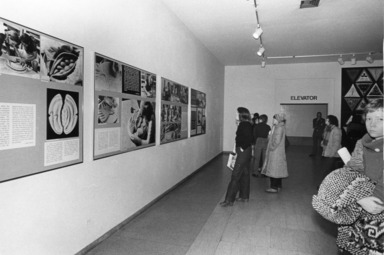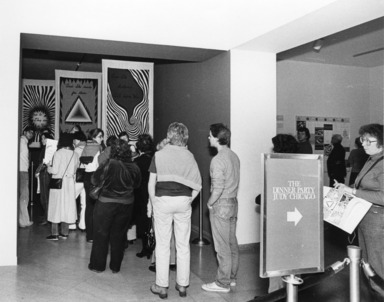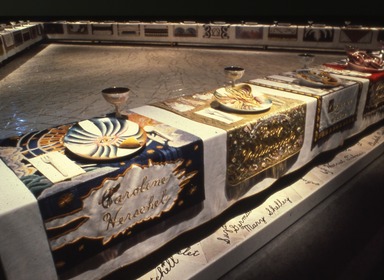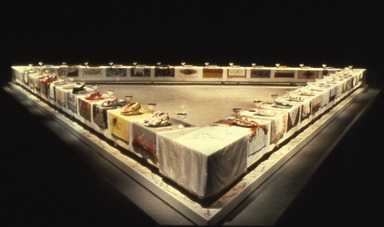

Judy Chicago: The Dinner Party, October 18, 1980 through February 01, 1981 (Image: PSC_E1980i003.jpg Brooklyn Museum photograph, 1980)

Judy Chicago: The Dinner Party, October 18, 1980 through February 01, 1981 (Image: PSC_E1980i004.jpg Brooklyn Museum photograph, 1980)

Judy Chicago: The Dinner Party, October 18, 1980 through February 01, 1981 (Image: PSC_E1980i005.jpg Brooklyn Museum photograph, 1980)

Judy Chicago: The Dinner Party, October 18, 1980 through February 01, 1981 (Image: PSC_E1980i006.jpg Brooklyn Museum photograph, 1980)

Judy Chicago: The Dinner Party, October 18, 1980 through February 01, 1981 (Image: PSC_E1980i007.jpg Brooklyn Museum photograph, 1980)

Judy Chicago: The Dinner Party, October 18, 1980 through February 01, 1981 (Image: PSC_E1980i008.jpg Brooklyn Museum photograph, 1980)

Judy Chicago: The Dinner Party, October 18, 1980 through February 01, 1981 (Image: PSC_E1980i009.jpg Brooklyn Museum photograph, 1980)

Judy Chicago: The Dinner Party, October 18, 1980 through February 01, 1981 (Image: PSC_E1980i010.jpg Brooklyn Museum photograph, 1980)
Judy Chicago: The Dinner Party
-
October 18, 1980
The Dinner Party is a monumental environmental sculpture that confronts, challenges, and raises issues concerning women’s history and sexuality, politics in art, and the definition of art vs craft. The work by California artist Judy Chicago will make its New York debut at The Brooklyn Museum October 18, 1980-January 18, 1981. Considerable discussion among the public and members of the art community has followed the piece on its tour of San Francisco, Houston, and Boston, as well as during periods when the piece was stored due to cancellations of museum showings.
Michael Botwinick, Director of The Brooklyn Museum, explains his reasons for inviting Chicago to show The Dinner Party at Brooklyn. “New York, being the art center of the United States, is used to the ferment of many different exciting ideas. Our role in this is a catalytic role. We are bringing The Dinner Party to New York to allow the many people we think will be interested--the artistic establishment, the universities, the students, artists, dealers, the people who have heard about the piece through the media--to see the object first-hand and make their own judgements. Public interest in The Dinner Party has been unusually high on the grass-roots level. We are particularly grateful to Brooklyn Borough President Howard Golden and Nanette Rainone, Special Assistant, for their early efforts in support of the Brooklyn showing.”
Chicago, whose intent in The Dinner Party is to “convey women’s history through art in a way that will make both women’s experience women’s art more significant," is accustomed to challenges and is gratified by the pride so many visitors to The Dinner Party take in the work.
While Chicago worked alone the first two years, The Dinner Party eventually took 400 people five years to complete the project. It took two years to research the histories of the 39 real and mythical women represented at the open triangular table and the 999 additional women of achievement whose names are inscribed on the porcelain floor. Though The Dinner Party is one woman’s conception, the complexities of the ceramics, needlework, and installation reflect the collaborative atmosphere of Chicago’s studio.
Each of the 48-foot sides of the table supports 13 place settings. Each woman is symbolized by a dramatic, colorful porcelain plate, painted with traditional china-painting techniques. The plates are placed on decorative fabric runners representing the woman’s cultural and historic period and using needlework techniques from the time. Chicago deliberately chose to work with historically female crafts as a means of honoring the women who had preserved the traditions.
The exhibition includes a photo-documentation area describing the process. It introduces some of the people who worked on the project and discusses the ceramic and needlework methods used, the vast amount of information uncovered, and the experience of working as part of such a large group. Six banners, woven in the manner of French Aubusson Tapestries, will hang in the entryway to The Dinner Party.
Judy Chicago will discuss The Dinner Party with the public on Saturday, October 25, at 2 PM. The program fee is $5.00 (admission to the Museum is included), $2.50 for students and senior citizens. An Acoustiguide tour of the exhibition recorded by Chicago will be available. “Right Out of History,” a film by Johanna Demetrakas documenting the behind-the-scenes process of The Dinner Party, will be shown Saturdays, October 18 and November 1, at 2 PM (additional showings will be announced).
Also accompanying the exhibition will be three Anchor Press/Doubleday Publications: a new book, Embroidering Our Heritage: The Dinner Party Needlework ($15.95) by Judy Chicago and Susan Hill; The Dinner Party: A Symbol of Our Heritage ($12.95) by Judy Chicago; and Through the Flower ($4.95), Chicago's autobiography.
The sincere interest in The Dinner Party is evidenced by the extensive list of people who have lent their financial support to the
Brooklyn venue: Vera G. List, Werner H. Kramarsky, Ann R. Roberts, Women’s Fund-Joint Foundation Support, William Woodward, III, Flora F. Wade, The Philip M. Stern Family Fund, The Louise L. Ottinger Charitable Trust, Muriel F. Siebert Foundation, Rhonda Schaller, Deborah Rose Chromow, Alida Rockefeller Dayton, Athena Tacha Spear, Deborah L. Perry, Rose B. Heller, Nosutch Foundation of California, James B. Horton, Dr. Gary Soldati, Domna C. Stanton, Adelaide De Menil, Christie Hefner, Holly Harp, Joan Palevsky, Anne Helen Hess, Walter F.H. Mattlage, Margery E. Elliott, Dr. Cecily C. Selby, Shana Alexander, Laura Gardner, Mr. and Mrs. Thomas B. Morgan, Carole S. Hyatt, Marilyn French, Mr. and Mrs. Ernest Heller, Gordon Davidson, Barbara C. Burhans.
Arts, Letters, and Politics have assisted with fundraising for this project.
Brooklyn Museum Archives. Records of the Department of Public Information. Press releases, 1971 - 1988. 1980, 047-49.
View Original -
October 18, 1980
The Dinner Party, a monumental room-sized sculpture conceived and directed by California artist Judy Chicago, will make its New York debut October 18, 1980 at The Brooklyn Museum. The work, which will be on view through January 18, 1981, has provoked considerable discussion around the country and within the art world.
Michael Botwinick, Director of The Brooklyn Museum, explains his reasons for inviting Chicago to show The Dinner Party at Brooklyn. “New York, being the art center of the United States, is used to the ferment of many different, exciting ideas. Our role in this is a catalytic one. We are bringing The Dinner Party to New York to allow the many people we think will be interested--the artistic establishment, the university community, artists, dealers, people who have heard about the piece through the media--to see the object first-hand and make their own judgements. There has been tremendous grass-roots interest in The Dinner Party. We are particularly grateful to Borough President Howard Golden and Nanette Rainone, Special Assistant, for their early efforts in support of the Brooklyn showing.”
Chicago, whose intent in The Dinner Party is to "convey women’s history through art in a way that will make both women’s experience and women’s art more significant,” is encouraged by the reaction of the public to The Dinner Party. “A powerful work of art has the ability to shape the way we see reality, which women have not participated in,” says Chicago.
Carefully researched, The Dinner Party contains 39 place settings executed in innovative ceramic techniques and traditional china painting and needle work processes. Each place setting represents a mythic female character or historic figure who has made a significant contribution to womens’ lives throughout history. The triangular table, measuring 48-feet on each side, rests on a tiled floor inscribed with the names of 999 additional women of achievement.
Brooklyn Museum Archives. Records of the Department of Public Information. Press releases, 1971 - 1988. 1980, 032.
View Original




















